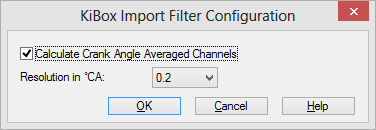Import of KiBox Files¶
The Uniplot-Add-In “KiBox Import” is used to evaluate KiBox data files.
Installation¶
To enable the Add-In do the following:
Choose Tools=>Add-In Manager in UniPlot.
Check the addin KiBox Import.
Choose OK.
Usage¶
To import data from the KiBox file, do the following:
Choose File=>Import Data to open the File Open dialog box.
Choose the file type “KiBox file”.
Choose one or more KiBox files.
The KiBox file will be opened, the data will be read and saved in a netCDF file. The dataset can be loaded with the UniPlot-Import dialog box.
Configuration¶
Use the Tools=>KiBox Configuration to set the options for the KiBox import filter.

Options:
Calculate Crank Angle Averaged Channels
If this option is selected, the import filter will create averaged channels
from all channels measured with a resolution of 0.1 °CA. The channel names are
created by adding the text _mean to the channel name.
Resolution in °CA
The resolution for the averaged channels can be set to 1.0 °CA, 0.5 °CA, 0.2 °CA or 0.1 °CA.
Unit Converter¶
For KiBox files the channel units will be converted using the UniPlot unit converter. In this version all units specified in the converter are converted into the default units.
The units are converted during import (*.open to netCDF file *.nc) using
the linear scaling defined in the unit table.
The following steps are executed:
Lookup a given unit in the Alias table. If the unit text does exist in the Alias table the standard unit string is returned. Example: For “J_per_m3rad” the Alias table contains the standard unit “J/(m³ rad)”. If the unit is not listed in the Alias table the search will return the given unit.
With the result from the Alias table, UniPlot will lookup the preferred unit and scale the data with the specified factor and offset. Example: The alias search returned “kPa”. The preferred unit for “kPa” is “bar”. The data will be converted to “bar”.
The Unit Converter compares strings only to find the scale factor and offset. The search is case sensitive. The unit strings can contain any UNICODE characters. Spaces are not ignored.
If you want to convert 1/s to 1/min both units must be specified in the
Units table.
See Unit Converter.
History
Version |
Description |
|---|---|
R2013.12 |
Calculation of average channels added. |
id-1914462